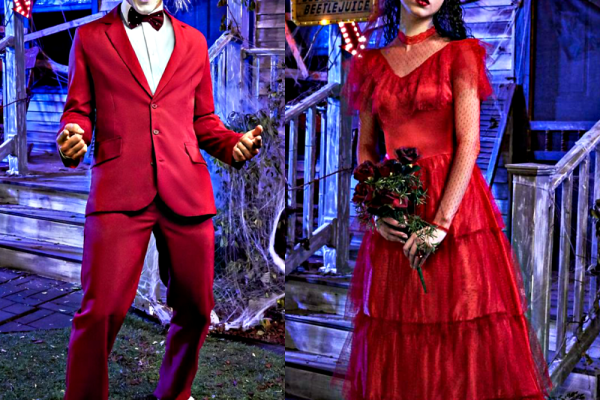Introduction to Vietnamese Wedding Dresses
Wedding dresses in Vietnam, notably the Áo Dài, are symbols of cultural heritage, beauty, and elegance. This traditional outfit holds a special place in Vietnamese weddings and represents the rich history and customs of the nation. The design and craftsmanship of the Áo Dài reflect the country’s artistic expression, while the colors and fabrics often hold significant meaning. As Vietnam continues to evolve, the wedding dress retains its charm, merging tradition with contemporary influences. Understanding the nuances of the Vietnamese wedding dress is essential for those looking to appreciate or participate in this beautiful cultural celebration.
The Significance of the Áo Dài
The Áo Dài is not just a wedding dress; it is a symbol of national pride in Vietnam. The outfit consists of a long tunic that extends down to the ankles, worn over fitted trousers. Historically, the Áo Dài has evolved from a more loose-fitting garment to the sleek and form-fitting design seen today. This transformation mirrors the changes in Vietnamese society, reflecting both cultural heritage and modern influences.
The elegant silhouette of the Áo Dài is believed to represent feminine beauty. The dress accentuates the natural curves of the body while maintaining modesty. As such, it is often chosen for various celebrations and events, but it holds particular significance during weddings. The inclusion of the Áo Dài in a wedding ceremony signifies respect for cultural traditions and the importance of family values.
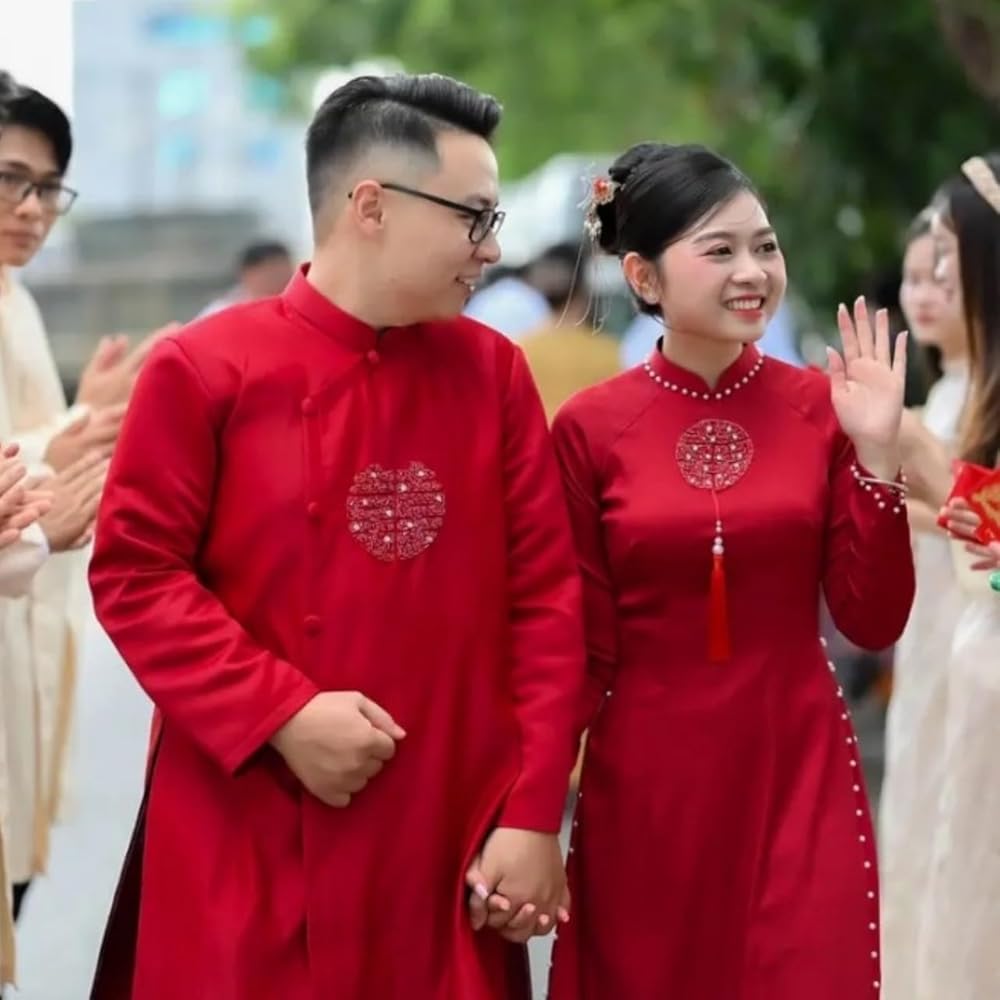
Cultural Elements in Design
Vietnamese wedding dress showcase various cultural elements through their design, color, and embroidery. Each aspect tells a story and connects the couple to their heritage.
Colors and Their Meanings
The colors chosen for Vietnamese wedding dress carry deep meanings. Red and pink are the most popular colors for weddings, symbolizing good fortune, happiness, and prosperity. Couples often choose these vibrant shades to attract positive energy and blessings for their union. Red, in particular, is associated with celebration and joy, making it an ideal choice for such a significant occasion.
Gold and white are also common colors for wedding dresses. Gold represents wealth and luxury, while white symbolizes purity and a new beginning. Many brides opt for a combination of these colors, creating a visually stunning outfit that embodies their hopes for the future. The color choices in Vietnamese wedding dress reflect not only individual preferences but also cultural significance.
Intricate Embroidery and Patterns
In addition to colors, the use of embroidery and patterns elevates the beauty of Vietnamese wedding dress. Elaborate designs often incorporate floral motifs, which symbolize growth, love, and beauty. Common symbols include lotus flowers and peonies, both revered in Vietnamese culture. Handmade embroidery adds a unique touch to each dress, making it one of a kind.
The meticulous craftsmanship involved in creating these dresses showcases the skills of Vietnamese artisans. Many brides value the opportunity to commission a dress that reflects their personal story and aesthetics. This connection to craftsmanship highlights the importance of tradition and artistry in Vietnamese wedding celebrations.
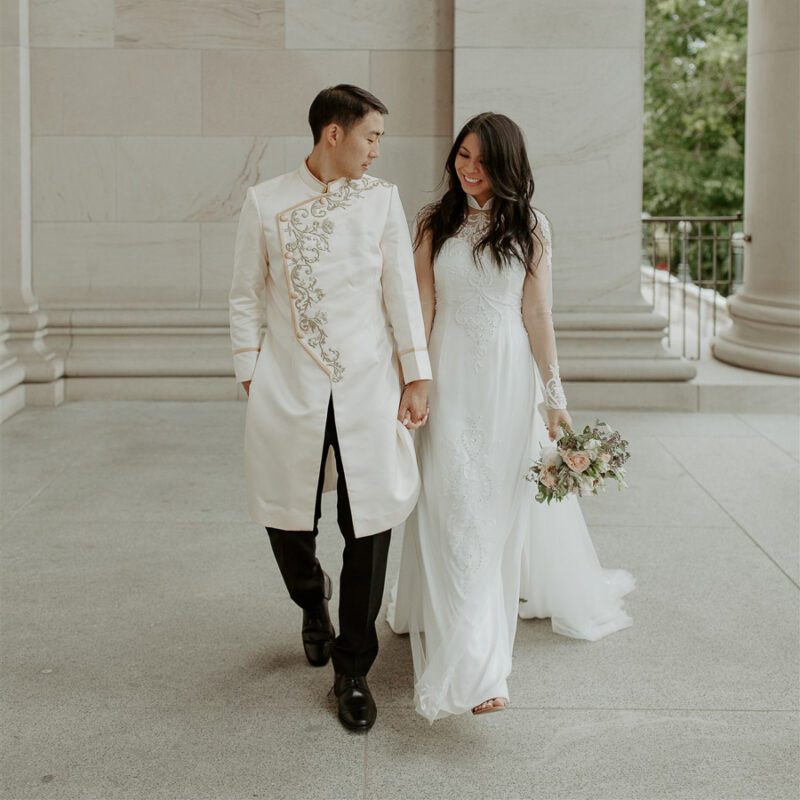
Modern Interpretations of the Áo Dài
As Vietnam continues to modernize, so too does the Áo Dài. Contemporary designers have begun to experiment with the traditional dress, creating fresh interpretations that mesh tradition with modern sensibilities.
Stylish Cuts and Fabrics
Modern Áo Dài designs often play with cuts and fabrics. While traditional designs feature silk or cotton, modern interpretations include a variety of materials, such as chiffon and lace. These fabrics create an ethereal look that appeals to brides wanting elegance with a touch of modern flair.
Additionally, designers may alter the cut of the dress to include asymmetrical hems or flared sleeves. These stylistic choices allow brides to express their individuality while maintaining ties to tradition. The flexibility of modern designs enables each bride to find an Áo Dài that resonates with her personal style, while still honoring cultural roots.
Fusion with Western Styles
Many brides today choose to fuse the Áo Dài with Western bridal fashion elements. This can include incorporating a wedding gown style while retaining the iconic silhouette of the Áo Dài. For instance, some may choose to wear a traditional Áo Dài for the ceremony and switch to a Western-style gown for the reception. This blend of styles allows brides to honor their culture while also embracing contemporary wedding trends.
Accessories also play a role in this fusion. Brides may opt for Western-style veils or statement jewelry to enhance their outfits. The combination of traditional and modern elements creates a unique wedding look that speaks to the bride’s background and personality.
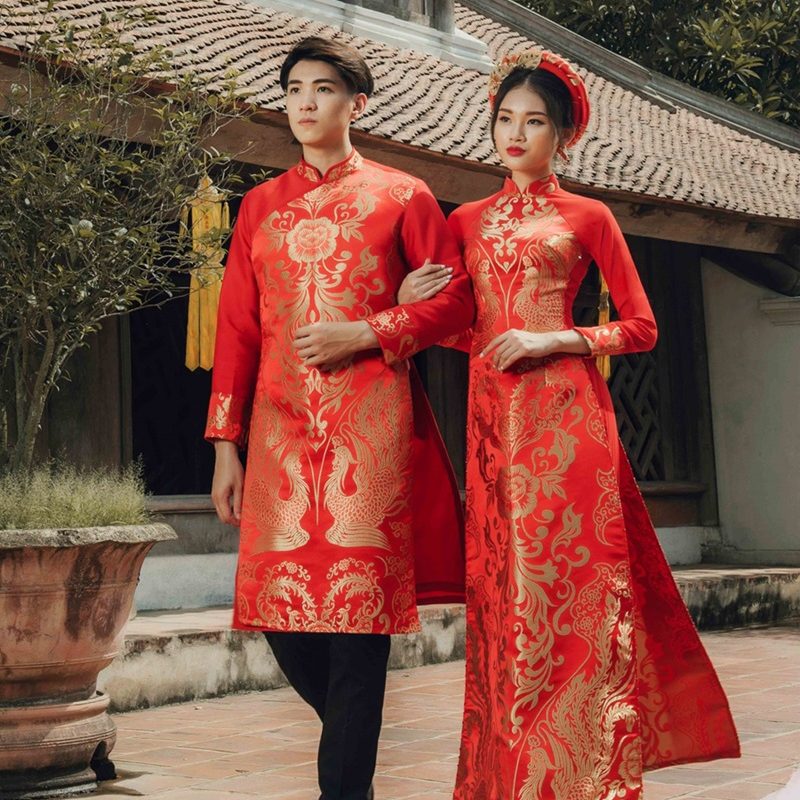
The Role of the Groom’s Attire
While the bride’s outfit captures much of the attention, the groom’s attire is equally important. In Vietnamese weddings, both partners often dress in traditional outfits, complementing each other’s style.
Traditional Groom’s Attire
Traditionally, grooms may wear an Áo Giao Lĩnh, which consists of a long tunic paired with loose trousers. The outfit is typically made from silk or brocade and comes in various colors, often complementing the bride’s attire. This tunic features a high neckline and intricate motifs that celebrate Vietnamese culture.
The groom’s outfit represents respect and tradition, much like the bride’s. By wearing a classic garment, grooms honor their heritage and present themselves elegantly on their big day. Matching colors or patterns with the bride creates a cohesive look that signifies unity.
Modern Groom’s Styles
Similar to the evolution of the bride’s dress, modern grooms may choose to incorporate contemporary styles into their wedding attire. Some opt for tailored suits that still reflect their cultural roots. Others may choose to wear a Western-style suit and tie, adding personal touches such as accessories inspired by traditional Vietnamese culture.
Many grooms are willing to experiment with colors, choosing shades that stand out or match their partner’s dress. This blend of modern styles with traditional aesthetics allows each couple to create a unique look that represents their love story.
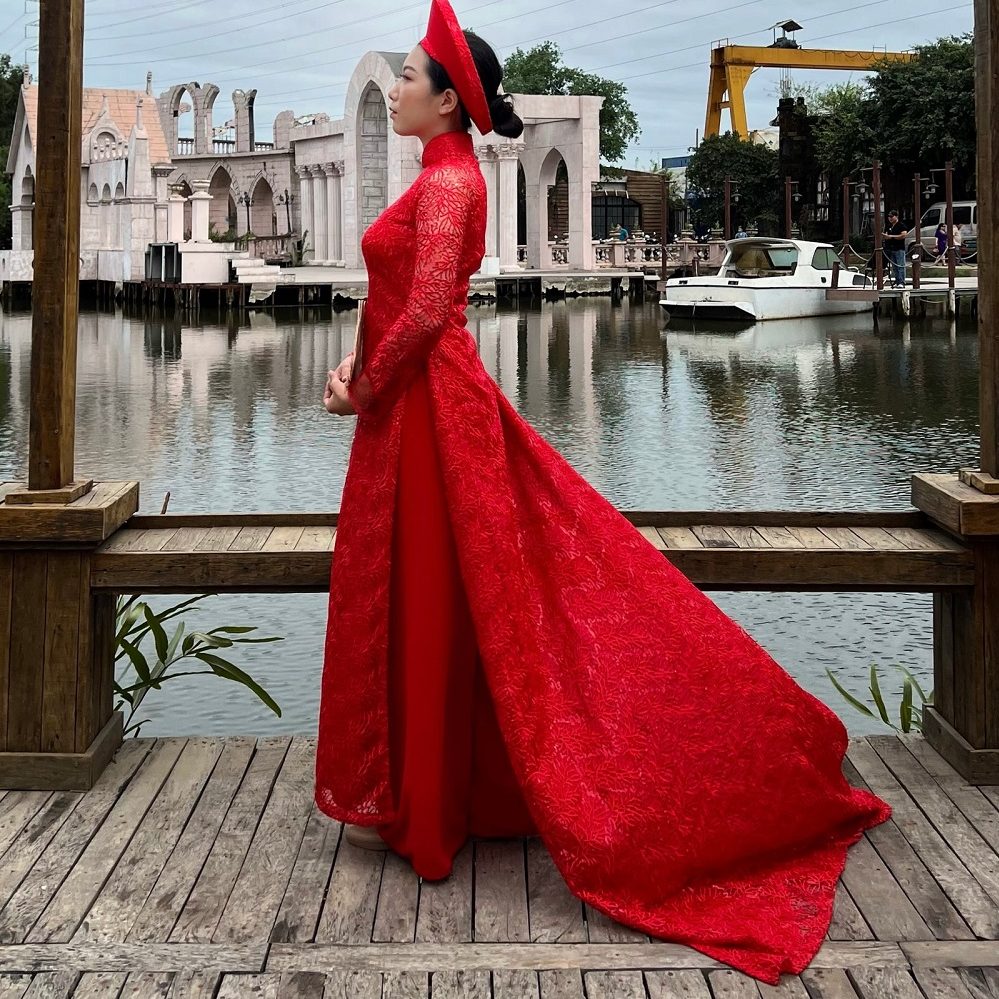
Planning for the Wedding Day
When planning a wedding, considering the attire is crucial for both the couple and their families. Understanding cultural traditions, as well as personal preferences, ensures a harmonious celebration.
Involvement of Family
In Vietnamese culture, family plays a significant role in wedding preparations. It is common for families to be involved in selecting and designing the bride’s dress. Many mothers or grandmothers may pass down traditional dresses or help in choosing colors and styles that hold cultural significance. This involvement adds a sense of continuity and love to the wedding process.
Additionally, family members may also aid in organizing other aspects of the wedding, ensuring that traditions are honored. This collective effort fosters unity and strengthens family bonds, making the wedding day even more meaningful.
Considerations for the Wedding Venue
The choice of wedding venue can also influence decision-making in terms of attire. For outdoor ceremonies, lightweight fabrics may be preferable to ensure comfort in warm weather. Indoor venues may allow for more elaborate outfits, as weather conditions are controlled.
Brides and grooms should consider how their attire will align with the overall theme of their wedding. Each component, from the wedding dress to the venue decoration, should tell a cohesive story. This harmony helps create a memorable experience for everyone involved.
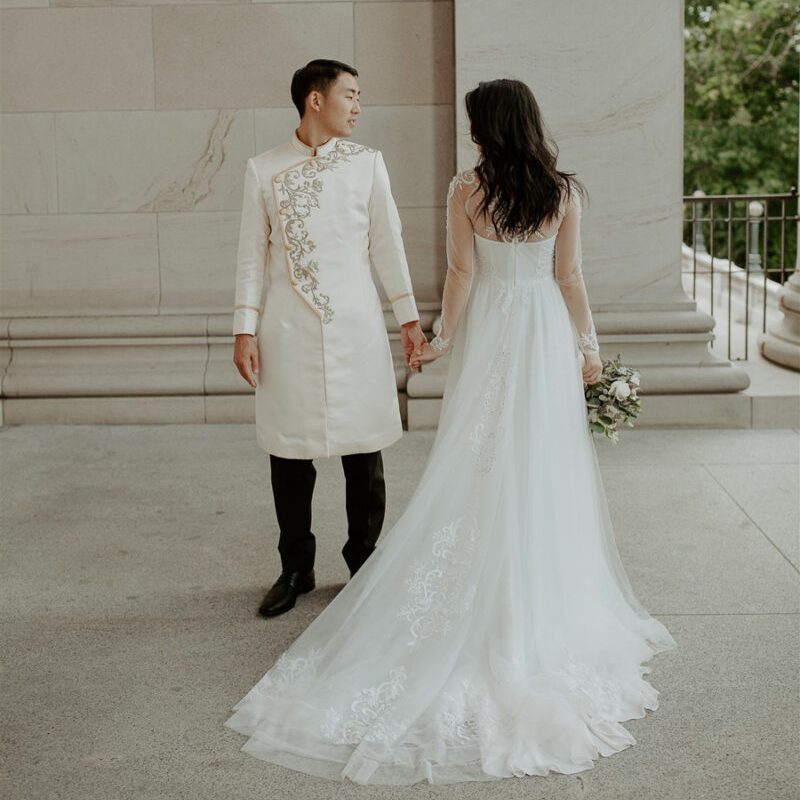
Challenges Faced by Brides and Grooms
While planning a wedding can be an exciting time, it also comes with its share of challenges. From garment fitting to cultural expectations, couples may experience various hurdles in the process.
Finding the Right Designer
One of the significant challenges brides may face is finding the right designer for their wedding dress. With many options available, it can be overwhelming to choose the right one that aligns with their vision. Brides must take the time to research local designers, read reviews, and explore galleries of previous work. Visiting shops and discussing individual preferences helps in developing the ideal design.
For many couples, the goal is to find a talented designer who respects their vision while also embracing cultural traditions. This collaborative relationship will lead to a gown that showcases both the bride’s style and cultural significance.
Fitting and Adjustments
Ensuring the perfect fit is another important aspect. As each bride has a unique body shape, garments may require multiple fittings for optimal comfort. This also applies to the groom’s attire, requiring attention to detail to ensure the right fit.
While fitting appointments can be time-consuming, they are essential to achieving the desired look. Working closely with tailors and designers will help address any concerns. Adjustable features can also be incorporated to accommodate experiences like weight fluctuations leading up to the wedding day.
Conclusion: Celebrating Love and Heritage
In conclusion, the Vietnamese wedding dress, particularly the Áo Dài, is a beautiful celebration of culture and elegance. The importance of incorporating traditional elements into the wedding attire is evident in both the bride’s and groom’s fashions. With a variety of styles and designs available, couples can express their love and personality while honoring their heritage.
Embrace Tradition and Individuality
As you plan your special day, embrace the rich traditions surrounding Vietnamese wedding attire. Remember to consider how these elements reflect your unique love story. Choose styles, colors, and designs that resonate with both of you, including beautiful watercolor wedding invitations, ensuring a memorable celebration.
Investing time and thought into these garments will enhance not only the beauty of the day but the meaningful connections formed with family. Celebrating love and unity through tradition elevates the wedding experience, creating cherished memories that unite generations. As you wear the Áo Dài or the Áo Giao Lĩnh, may it serve as a symbol of not just your love, but the beauty of your shared heritage, making your wedding day truly unforgettable.

